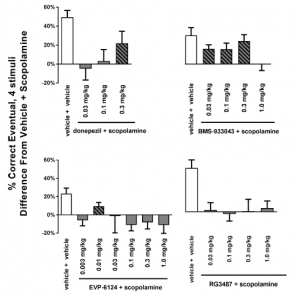7.3.1 – Specific Neurotransmitter-based Treatments
The 5-HT6 receptor is a cholinergic receptor with a poorly understood role in the pathology of AD, although it is known to have an influence in cognition, has a positive correlation with Alzheimer’s disease and is mainly found in the cilia of the hippocampus. In a paper by Hu et al., 5-HT6 overexpressing, control, and knockout mice were compared by looking at the hippocampal cilia to see what effect it had in APP/PS1 mice, while confirming effects on memory by using a variety of memory tasks. What they found was that 5-HT6 had a significant positive relationship with cilia length, the increased concentration in APP/PS1 mice leading to an increased cilia size compared to wild type mice. On top of that, it was found to have other significant morphological effects, such as a decrease in axonal size, suggesting that 5-HT6 may have cognitive effects in Alzheimer’s through inhibiting the transport of information and perhaps reducing the efficiency of transfer through their morphological changes. Inhibition of 5-HT6 reduced cognitive impairment in APP/PS1 mice in the memory tasks, suggesting again some connection between the cilia’s morphology changes and cognition, and making the receptor a more viable target for AD treatment.
Another receptor that has been often tested is the nicotinic acetylcholine alpha 7 receptor. Agonists of this receptor have been shown to improve memory and cognitive function across animal models consistently, and in tests an antagonist of this receptor, scopolamine, is commonly used to create models of Alzheimer’s, as well as test the effects of various drugs on cognition. Some of these drugs come up later on, but an example of an agonist test comes from Weed et al., who tested the effect of donepezil, an acetylcholinesterase inhibitor, as well as three unnamed agonists, BMS-933043, EVP-6123 and RG-3487 on scopolamine-treated monkeys in a visual spatial learning task. Treatment resulted in significantly improved scores on the task vs scopolamine treated monkeys in the case of donepezil as well as BMS-933043 and EVP-6124, strengthening the breadth of evidence that receptor agonists do actually have a significant effect on cognition in this model animal.

Figure 1: Results of agonists’ effect size compared to the baseline. Significant results are labelled with diagonal black lines, having an average 10 to 20% improval over the control + scopolamine result. Notable is the lack of significant result for RG3487, as the high benefits of BMS-933043 even at very low concentrations.
Some studies also test the effects of multiple receptor affecters in tandem, such as Ferris et al.’s study on an inhibitor for the aforementioned Serotonin 5-HT6 receptor, Idalopirdine, in conjunction with an acetylcholinesterase inhibitor, donepezil. By doing an MRI on the brain of an awake rat as it responded to the administration of the two drugs individually as well as in tandem, they were able to directly compare the functions of each drug as well as see what effect they had when taken together by comparing the brain regions activated. Interestingly, when taken together, it was found that rather than activating the expected number of brain regions, which was the 8 from idalopirdine and the 19 that were measured from donepezil at their respective peaks to a total of 27, they found 36 brain regions were activated, suggesting that interplay between the two drugs leads to more robust effects, an even greater achievement when considering the effects were scattered across three neural networks while enhancing the effect size of their individual effects. This shows it may be worth considering the use of other drugs together in tandem as they may have more effects than the sums of their parts, just like these two happened to.
